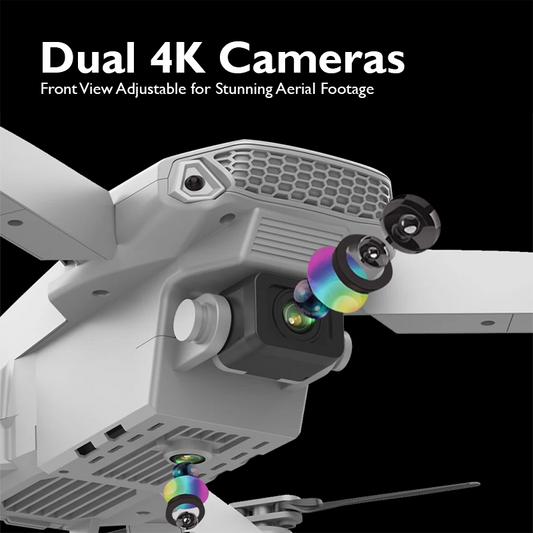Indoor Drone Flying: Tips for Safe and Fun Flights

Indoor drone flying has gained immense popularity among enthusiasts who seek the thrill of piloting their drones in the comfort of their homes. Whether you're a seasoned drone pilot or a beginner, mastering indoor flights requires a unique set of skills and precautions. In this guide, we'll delve into valuable tips to ensure safe and enjoyable indoor drone flying experiences.
1.Choose the Right Drone:

Selecting an appropriate drone for indoor flying is crucial. Opt for smaller, lightweight drones with propeller guards to minimize the risk of damage to both the drone and your surroundings. Drones equipped with obstacle avoidance technology can be an added advantage for navigating confined spaces.
2.Understand Your Drone:
Before taking flight, thoroughly read the user manual provided by the drone manufacturer. Understanding the drone's features, flight modes, and safety guidelines will enhance your ability to control the device effectively. Familiarize yourself with the remote control and practice basic maneuvers in an open space before attempting indoor flights.
3.Prepare the Indoor Environment:

Create a safe flying environment by removing any obstacles or fragile items that could be damaged during flight. Clear the space of valuable objects, fragile decorations, and other potential hazards. Designate a dedicated area for indoor flying to minimize the chances of accidents.
4.Check and Charge Batteries:

Ensure your drone's batteries are fully charged before each indoor flight session. Regularly inspect the batteries for any signs of damage or wear. Having spare batteries on hand can extend your flying time and reduce downtime between flights.
5.Calibrate Sensors and Compass:

Calibrating your drone's sensors and compass is essential for accurate navigation. Follow the manufacturer's guidelines to calibrate your drone before each indoor flight to prevent unexpected behavior and ensure stable flight performance.
6.Master Basic Maneuvers:
Practice basic maneuvers in a controlled environment to enhance your flying skills. Mastering simple tasks such as hovering, landing, and flying in a straight line will build confidence and improve your ability to navigate the drone indoors.
7.Utilize Altitude Hold Mode:
Many drones come equipped with an altitude hold mode, which automatically maintains a consistent altitude. This feature can be particularly beneficial for indoor flying, allowing you to focus on controlling the drone's direction without worrying about altitude adjustments.
8.Fly in Headless Mode:

Headless mode simplifies drone control by orienting the drone's movement based on the pilot's position, rather than the drone's front. This can be advantageous for beginners, making it easier to pilot the drone without worrying about its orientation.
9.Avoid Turbulent Airflows:

Indoor environments can create turbulent airflows, which may affect the stability of your drone. Minimize the impact of airflows by flying in spacious areas and avoiding proximity to fans, air conditioners, or open windows.
10.Use Propeller Guards:

Adding propeller guards to your drone is a wise investment, especially for indoor flying. Propeller guards provide an extra layer of protection against collisions with walls or furniture, reducing the risk of damage to both the drone and surrounding objects.
11.Be Mindful of Wi-Fi Signals:

Indoor spaces often contain numerous Wi-Fi signals from various electronic devices. Interference with these signals can impact your drone's connectivity and performance. Choose a frequency with minimal interference and, if possible, fly in a location with a stable Wi-Fi environment.
12.Set Boundaries:

Establish clear boundaries for your indoor flying activities. Communicate these boundaries to others in your household to prevent interference during flight. Having a designated flying area helps create a controlled environment, reducing the likelihood of accidents.
13.Practice Emergency Landing:

Be prepared for unexpected situations by practicing emergency landing procedures. Familiarize yourself with the emergency stop feature on your drone, allowing you to quickly regain control in case of a sudden issue.
14.Monitor Battery Levels:
Keep a close eye on your drone's battery levels during flight. Low battery levels can compromise stability and control. Establish a safe threshold for returning the drone to ensure it lands with sufficient power.
15.Record and Analyze Flights:

Many drones come equipped with built-in cameras or the ability to attach one. Record your indoor flights to review and analyze your piloting techniques. This can help identify areas for improvement and enhance your overall flying skills.
Indoor drone flying is a thrilling and rewarding hobby that, when done safely, can provide hours of entertainment. By choosing the right drone, understanding its features, and following these tips, you can ensure that your indoor flights are both safe and enjoyable. Whether you're a beginner or an experienced pilot, mastering the art of indoor drone flying opens up a world of creative possibilities right within the confines of your home.
Explore a variety of drones at our online drone store.Happy Flying











